Twenty Years On, The Little CubeSat Is Bigger Than Ever
5:51 minutes

This article is part of The State of Science, a series featuring science stories from public radio stations across the United States. This story, by Michelle Loxton, was originally published by KCLU.
The story of the CubeSat started with a big problem for one Cal Poly professor.
“It was actually a critical problem for us, but it was a problem that nobody else cared about,” said Jordi Puig-Suari, an Emeritus Professor from Cal Poly San Luis Obispo.
He co-invented the CubeSat with Bob Twiggs from Stanford.
Puig-Suari is now retired and has spent the last four years sailing around the world with his wife. I talked to him over Zoom from somewhere along that journey.
He takes me back two decades to his time as a professor at Cal Poly where he was hired to develop their aerospace engineering department.
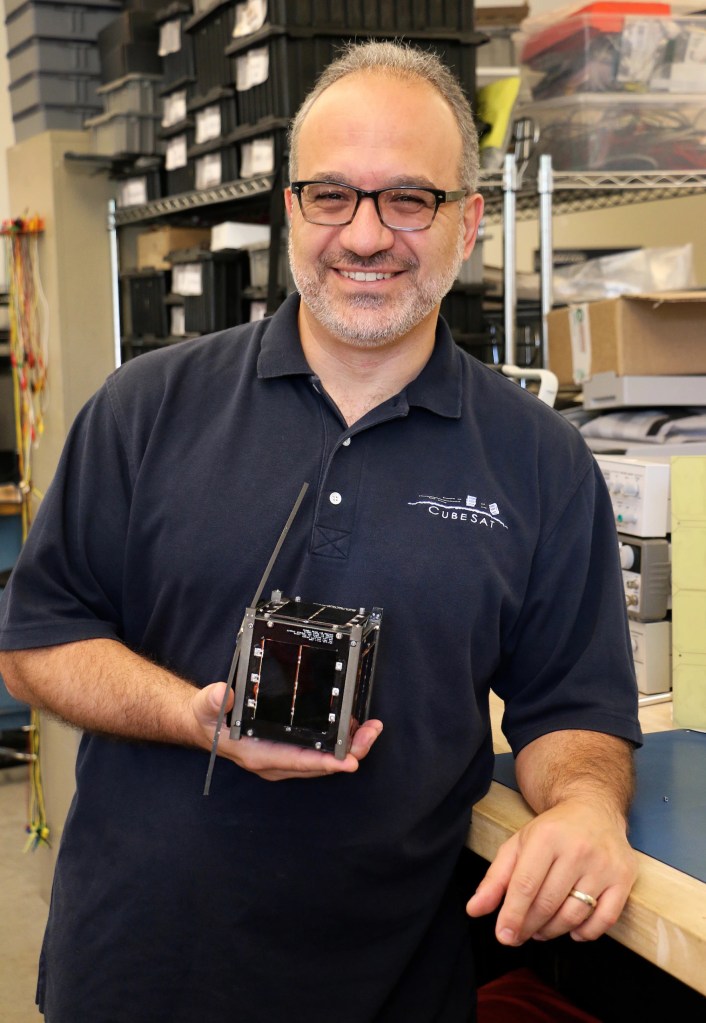
“So universities, we are trying to train students. I mean, Cal Poly in particular we learn by doing,” said Puig Suari. “And if you want to do space, we needed to get involved with touching space hardware.”
Satellites specifically – that ended up in space.
“But there were these never ending projects because launching them was very, very difficult,” he said.
You can build a satellite in a lab, but how do you get it into space? Not everyone has a rocket in their backyard. Puig-Suari said launching was almost impossible because there was very little access to the rockets that took stuff into space at that time. It was also very expensive.
“And what ended up happening is you would work on a satellite and it would take years and years and years to finish because you never had to finish,” said Puig-Suiari. “There is no launch.”
So making things for space that never ended up in space was a problem. So they set out to solve it.
What they needed to do was find some way to get their satellites onto the rockets that go into space.
“There’s probably a corner of the rocket somewhere where we can put this little thing. And the rocket guys, one won’t get too upset with us,” said Puig-Suari. “The other thing that happened is we very quickly realized that the launch providers were very concerned about carrying student satellites. There was a stigma to the fact that this is built by students: ‘It’s a risk to my mission’.”
So they thought, why don’t we make something that solves both of these concerns? Something very small that keeps all the risk safely contained inside it.
“Basically we call it a risk containment mechanism. We put all the risk inside this box and we said if the satellites break, if they don’t work. If something goes wrong, it will stay inside the box,” said Puig-Suari.
And so that is how the CubeSat was born.
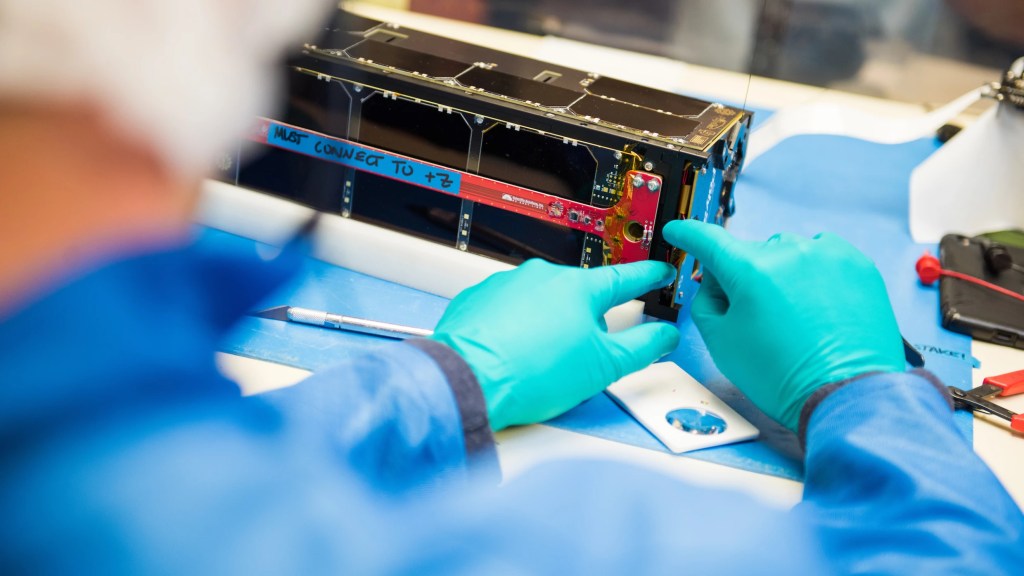
Now it’s important to clarify here exactly what they invented. The CubeSat is any satellite that conforms to an exact set of specs. It’s the specs you need to follow when creating the cube that contains everything inside your own very small satellite. The CubeSat is a dimensional standard. It doesn’t tell you what needs to be inside your satellite, it tells you how it needs to be contained if you want to send it into space.
“We don’t really get into what the satellites do. A lot of people feel that the standard controls the electronics or the radios or anything like that. And that’s not correct,” said Puig-Suari. “We’re primarily a dimension so that you fit in the standardized deployment mechanism.”
Think of it like when you take a carry-on suitcase on a flight. That suitcase has to be a specific size and shape otherwise it’s not going in the cabin… the CubeSat is a much stricter version of that, which happens to go to space. They go to space as auxiliary payloads on missions that are pre-planned.
So CubeSats are launched into space on a rocket – but they need to be deployed to actually do the work of the satellite. So Cal Poly needed a way to get the CubeSats off the rockets once they were in space. So they invented something called the P-Pod which houses the CubeSat and then pushes it out once it’s in orbit. Think of it like a jack-in-the-box.
“And then we put the CubeSats inside and they get deployed,” said Puig-Suai.
That’s ‘CubeSats’ – plural. Deployers with enough space for multiple CubeSats started being developed and it grew from there. Three unit CubeSats. Six unit CubeSats.
And this type of innovation was possible because the university made the CubeSat an open standard meaning they didn’t charge anything for it. They published their invention and said anybody can use it.
They do, though, still maintain the standard today so that there is that uniformity and as the name suggests a ‘standard’ across the industry.
CubeSats that go into space are really diverse… yes they all fit into the CubeSat standard and P-Pod or deployers, but once they’re in space they can open up and expand in so many different ways.
It all depends on what the CubeSat is sent up to do – what science is it testing or doing.
“But then when they get to orbit, people will deploy antennas, they’ll deploy solar panels, they’ll deploy all kinds of booms and other things,” said Puig-Suari. “So when you see them pictured in operation, they all look different. There’s all these different satellites that don’t really look the same, but they’re all CubeSats.”
They’re also much less expensive to make than the satellites of the past. Many call the CubeSat “the cheapest way to access space”. Before satellites would cost between $100 million to a few billions dollars to build. Today you’re looking at as little as $200,000 for CubeSat.
And it’s because you don’t need a huge building and massive facilities.
“With a CubeSat you can build a satellite on a tabletop and you can carry in a pelican case as the carry-on luggage on your flight,” said Puig-Suari.
For many countries the CubeSat was their first ever satellite. That includes Colombia and Switzerland. From there many countries followed – Hungary, Vietnam, the list goes on.
“When Columbia launched their first satellite, all their neighbors wanted one as well –b Peru launched a satellite,” said Puig-Suari. “And everyone was like, ‘Oh, if they can do it, we can do it too’.”
Puig-Suari was involved in over 100 CubeSat launches.
“And that was at a point where Cal Poly was basically managing all the launches for CubeSats in the United States. So NASA selected us to provide that service,” said Puig-Suari.
After a few years the university realized that this was becoming a commercial activity. Private industry needed to step up.
“So Planet is a very well known company now because when you’re watching the news and they’re showing you pictures of the earthquake in Turkey or something in Ukraine, they’ll always say these images by Planet,” explained Puig-Suari.
Planet realized they could put a telescope on a CubeSat and do Earth observation.
“And everybody said, ‘You’re crazy’. So they started a company and now with Planet, they have hundreds of satellites up, both CubeSats and bigger ones and they’re very successful at providing imagery for everybody,” said Puig-Suari.
There’s a CubeSat conference at Cal Poly each year attended by hundreds of people.
Researchers expect the global CubeSat market to reach $730 million by 2027, growing almost 20% over six years.
They are so popular today that it’s hard to keep track of all of them. They’ve almost become ubiquitous with launches.
“So it’s literally sometimes every week there’s been times when every few days there was a launch that carried CubeSats,” said Puig-Suari. “So it’s pretty regular right now.”
In an office park in San Luis Obispo, the team at Maverick Space Systems are hard at work helping their commercial and government clients get their CubeSats into space.
Inside their clean room they are testing one of their CubeSat deployers that they make themselves – remember the P-Pod from Cal Poly – Maverick have their own version called a N-LAS.
“It’s made of a mix of carbon fiber and aluminum. So the gold stuff you see is aluminum. And of course, the black stuff you see, the big panels, are carbon fiber,” said Vidur Kaushish, the co-founder and COO of Maverick Space Systems.
“And it’s essentially the size of a large cereal box you can buy at Costco and that’s the size of a six U CubeSat,” said Kaushish.
He’s wearing a hairnet, gloves and other protective gear as he handles their deployer which can fit six CubeSats inside. They will test that these satellites can survive the launch environment and that they are safe to launch. Then they bolt it to a rocket and send it to space.
“And then it goes to space. The rocket sends a signal, the door springs open and just like a jack-in-the-box, there’s a spring that pushes the satellite out,” said Kaushish.
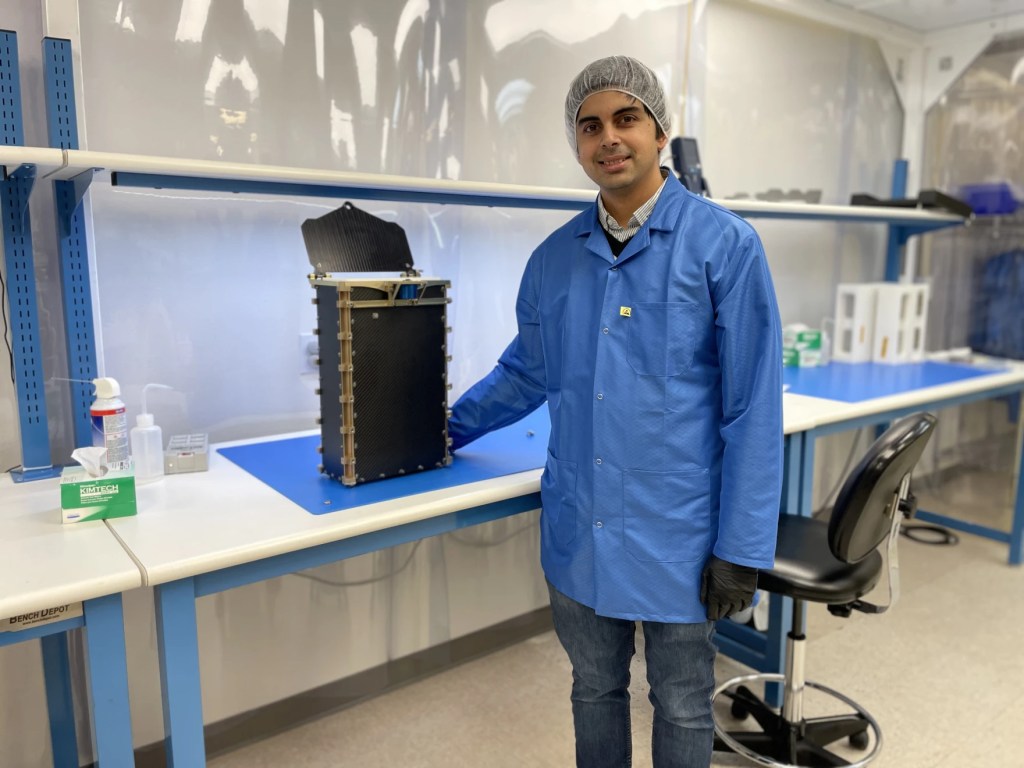
Maverick Space Systems is one of the private companies that was created because of the invention of the CubeSat.
Kind of think of them like a rideshare company – an Uber for satellites of different sizes – including CubeSats.
“If someone has built a satellite and they want to launch it to space, they come to us,” said Kaushish. “We find them a ride, we find a way to mount them to the rocket and deploy them in space.”
They have relationships with rocket companies who don’t want to deal with hundreds of customers and prefer to deal with just one middleman.
“So we bring the payloads to the launch vehicles. We handle the interface with all of these different customers so that Space X and Rocket Lab and all these other companies don’t have to,” said Kaushish. “We know what the launch vehicles are looking for. So we’re experienced in that field.”
They’ve sent all sorts of satellites into space for their clients. Satellites that do mapping of the Earth’s surface looking for resources like oil.There’s satellites that track shipping containers that fall off ships. And they helped NASA send a CubeSat to the moon.
“In the past we’ve worked with JPL [NASA’s Jet Propulsion Laboratory] and launched MarCO – Mars CubeSat One – which was the first interplanetary CubeSat. We didn’t build it, but we helped launch it and that feels great as well,” said Kaushish.
Kaushish says CubeSats have really helped commercialize and democratize space. He uses the word democratize because he says this invention has made space so much more accessible to a multitude of people.
“So you’re not limited to those big multimillion dollar companies that can afford to do this,” said Kaushish. “You can be a small startup. You can have a great idea and you can test it on a CubeSat and you can launch it for not that much money.”
Not far from Maverick Space Systems is the place when the CubeSat was invented.
“So right now we’re inside the clean room facility that we use to build our spacecraft,” said John Bellardo, the current director of the CubeSat Lab at Cal Poly San Luis Obispo.
We’re seated inside a room where the sounds of computer servers and a hard-at-work filtration system buzz in the background. Large plastic sheeting hangs from the ceiling separating work spaces; and posters and mechanical drawings from previous space missions adorn the walls.
“So we do everything from the design, the development, the building. And then finally, once we’re in orbit, the operations – that involves being able to communicate with a spacecraft over radio,” said Bellardo.
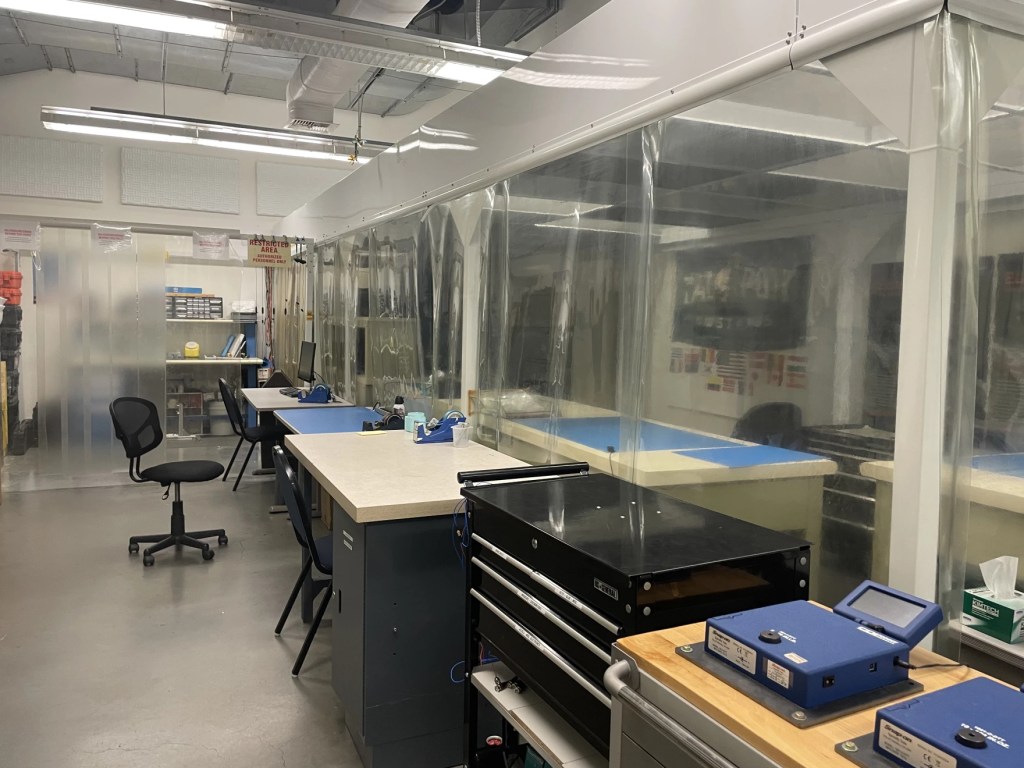
This lab has completely built and launched 14 CubeSats and has helped set up the launch of hundreds of others.
And their location – just down the road from Vandenberg Space Force Base – was a perk.
“That’s one of the real benefits of being an hour or so away from Vandenberg, is that when your spacecraft is being launched out of Vandenburg half the lab, three quarters, the lab will drive down there and watch,” said Bellardo.
Bellardo says the most exciting part of his job is working with students. Remember that’s why the CubeSat was invented in the first place.
“Cal Poly is known for ‘learn by doing’ and sort of hands-on education. And the CubeSat is in my mind, one of the great embodiments of that, because the students can spend a year, year and a half working on a spacecraft. But it’s not just theoretic in a lab somewhere. They’re actually touching the hardware. And then what they build ends up being launched and going to space,” said Bellardo.
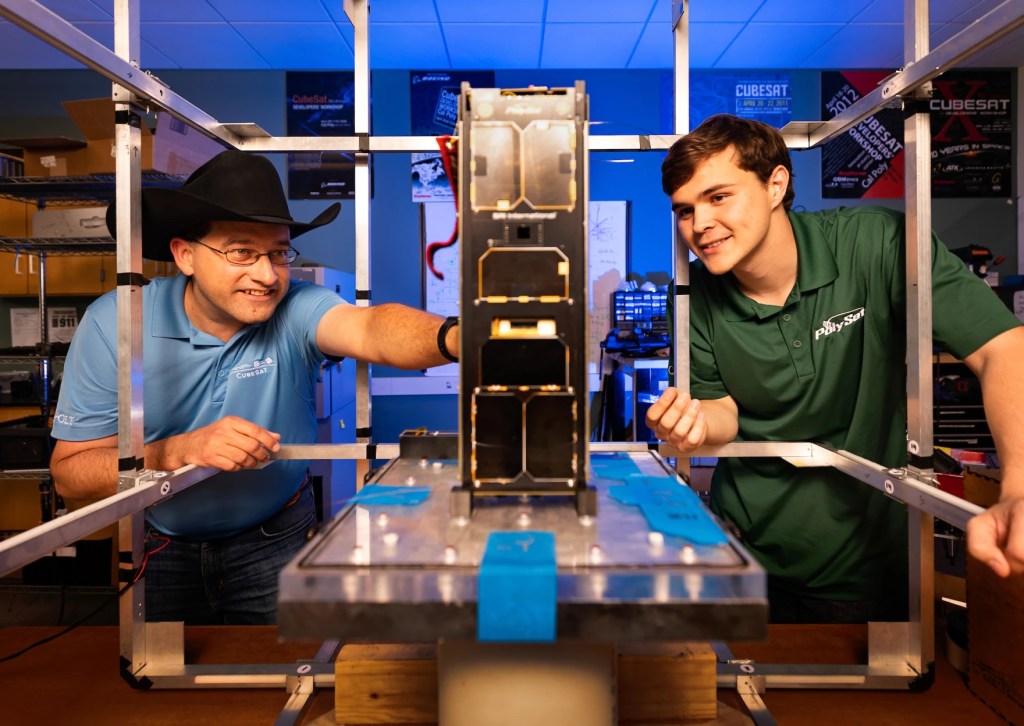
And they’re currently working on some really cool technology. You know – the stuff that goes inside the CubeSats.
One of their latest projects is to mitigate one of the biggest challenges in space right now and that’s space debris or junk. Currently objects may stay up in orbit for 25 years (older objects even longer – thousands of years). Cal poly’s space lab is working on technology that would help bring the object out of orbit faster. To do that they’re testing a sail – like you get on a boat – on a CubeSat.
“We’re using it more as a drag sail,” said Bellardo. “So even though space is a vacuum, it’s not totally devoid of particles. There’s still some molecules up there. Not very many, right, but enough that if you deploy a large sail off the back of your spacecraft, the particles are going to hit that sail and they will slow you down.”
The idea is that by slowing down the spacecraft, the orbit evolves, and it’s going to reenter the Earth’s atmosphere faster and burn up.
And students are heavily involved in these projects.
We leave the clean room facility and walk a short way across the campus. Bellardo points out two very large antennas on top of one of the buildings as we walk…
“Each one of those antennas has two different masts,” said Bellardo. “The masts are 16 feet long each. They’re pretty tall and they have to rotate to point at the spacecraft.”
We end up at a student-run research lab.
Inside textbooks fill shelves. Mechanical and electrical parts are scattered across workspaces where students are deep in conversation about their projects.
Alice Sukhostavskiy (who is studying aerospace engineering) and Kayla Del Rosario (who is studying mechanical engineering) are two of about 60 students that make up the team that tests and builds the CubeSats at Cal Poly.
“So the fact that I get to design hardware and build things I actually get to go into space is absolutely incredible because even as a fourth year undergrad, it still amazes me that I’m able to work on something so significant,” said Sukhostavskiy. “And people still tell me like, ‘Wow, I can’t believe you’re an undergrad and you’re working on something that goes into space’.”
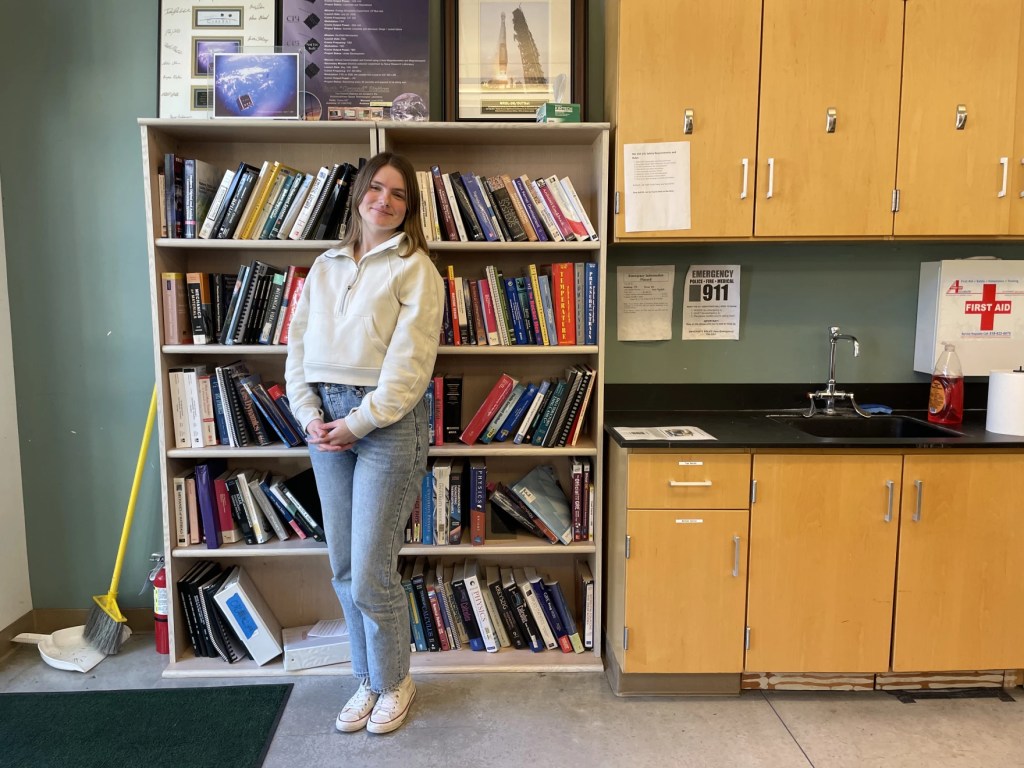
Kayla Del Rosario was turned on to the whole thing at her school orientation tour with an older student.
“He’s like ‘I can say to people I’ve worked on something right now that’s in space, that’s in orbit’. And I was like, That is so cool. And that’s what inspired me to join Lab,” said Del Rosario.
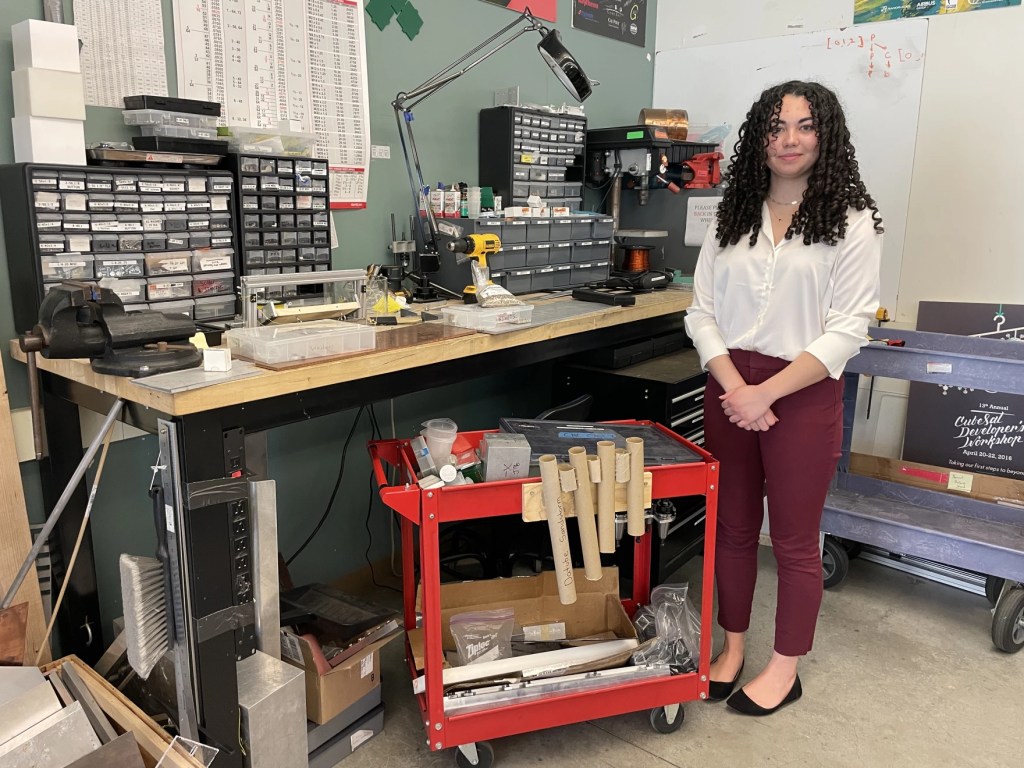
On a tour of the lab Sukhostavskiy shows me her favorite spots. She takes me over to a deconstructed model of a CubeSat. Imagine that square tissue box opened out lying flat on a table top. She puts on a metal bracelet that grounds her as she handles electronics so she doesn’t get shocked. This is a project they worked on a few years ago called FADE.
“It stands for Firefly Aerodynamic De-orbit Experiment. Unfortunately, FADE did not quite make it to orbit because Firefly, the rocket that FADE was flying on, unfortunately combusted and exploded in the atmosphere,” said Sukhostavskiy. “But it was a very good learning experience for us.”
The impact of the CubeSat has even made its way into high school classrooms.
Five students at Grace Brethren High School in Simi Valley are getting ready for a special class on CubeSats. Darren Yui is their teacher.
Yui teaches engineering at the high school. Today I am sitting in on their Spacecraft Engineering Class.
“Okay. So you guys should have worked on your flight software a little bit,” Yui said as he started the class. “I knew it was going to be a little bit challenging, so we’ll clarify that a little bit later and give you guys some time to work on that.”
Students are learning how to write requirements for a satellite. A small part of the process of creating a CubeSat.
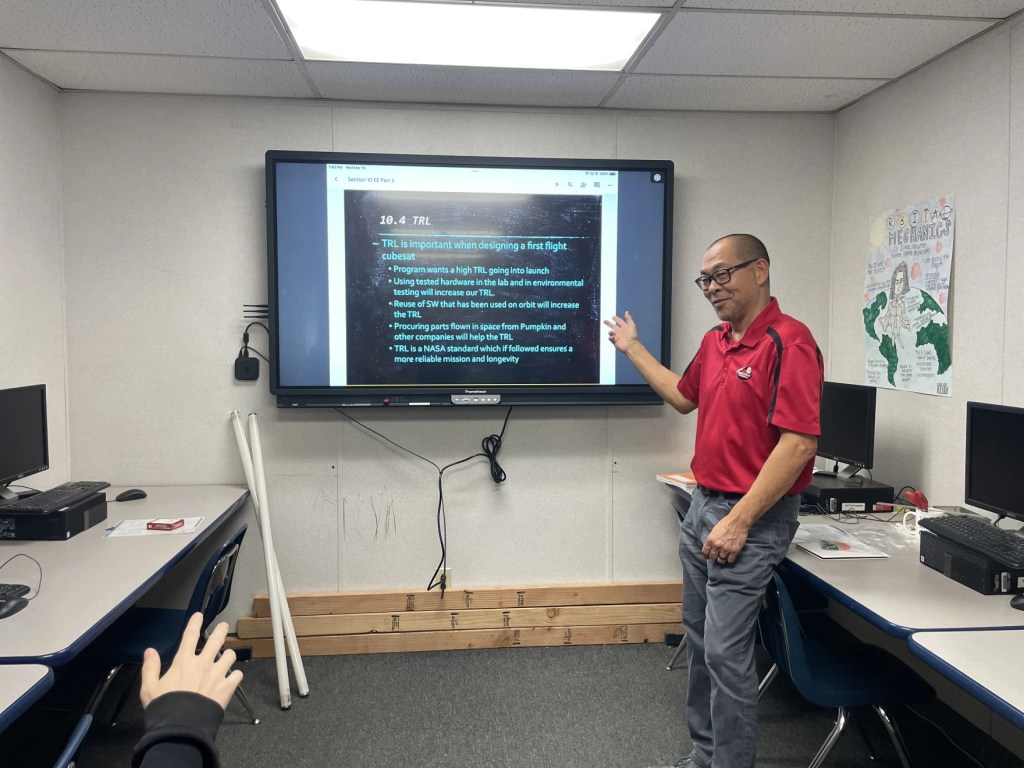
“Definitely the class has some very challenging concepts in it. They’re not things that normally students would be familiar with,” said Yui.
Besides his engineering classroom where all the theoretical work is taking place, Grace Brethren also has a Space Lab where students work on building things. Every year they try to create a CubeSatSim.
“A CubeSim is basically what they call an engineering model of a CubeSat. So it’s not space ready, but it has all the functionality of an actual CubeSat that you would send into space,” said Yui.
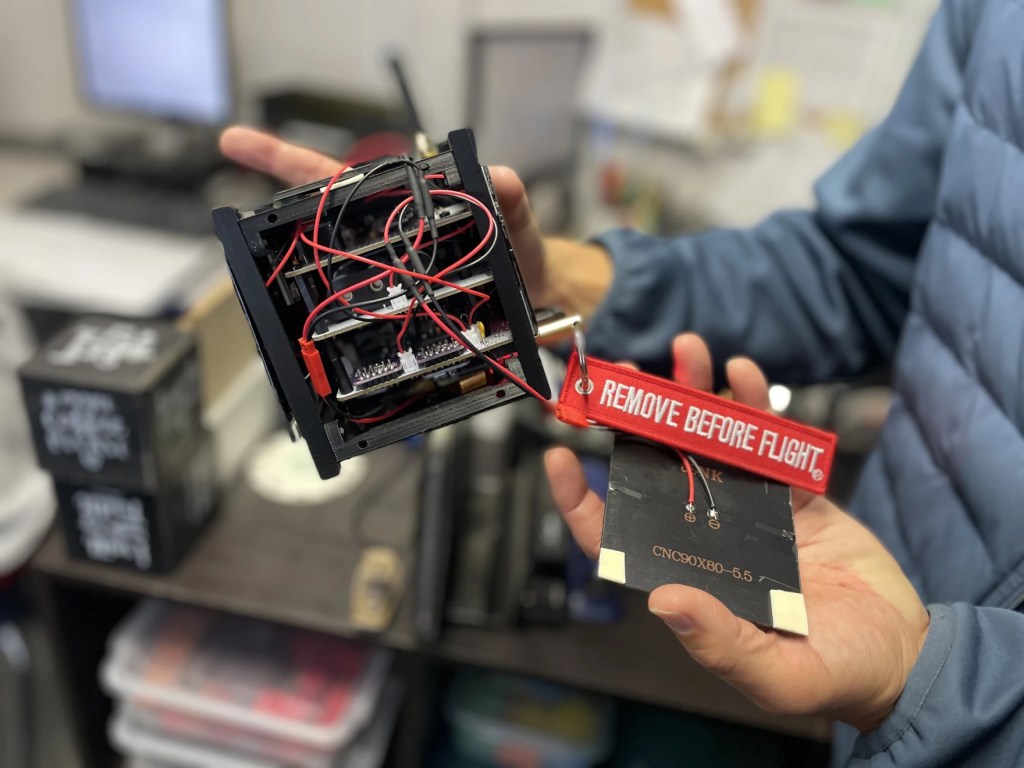
Yui says it’s a very remote possibility of them actually sending a CubeSat to space, ironically because the industry has opened up so much because of the invention of the CubeSat.
“It’s more competitive to get something out there. So you have to be really innovative in your ideas,” he said.
So no CubeSat launch in the near future but he’s not going to stop working on it.
“We would love to do that and that’s something I will continue to pursue as long as I’m here,” said Yui.
Yui’s students love learning about CubeSats. They believe what they learn in the class will have a positive impact on their future as they consider careers in the fields of engineering and aerospace.
“Space – I’m not a huge nerd on space, but I am a huge nerd on creating things,” said tenth-grader Grant Cobos. “There’s a lot of skills that go into putting the CubeSat together and it’s fun. I like learning and I like increasing my knowledge in those skills.”
From a classroom in Simi Valley, to an office park in San Luis Obispo, to the moon and beyond, Jordi Puig-Suari is very much aware of his invention’s legacy.
It really hits home for him when he travels back to his home country of Spain.
“I was born in Barcelona and wanted to build planes. And that’s something that Spain didn’t do,” said Puig-Suari. “So I went to the U.S. for school and moved from planes to satellites and the rest of history kind of thing – I stayed, which happens to a lot of people.”
Today because of his invention Spain is building its own CubeSats.
Puig-Suari is also proud of proving so many of their critics wrong.
“Nobody believed these things could do anything when we started. But we were okay because we wanted to train students. And that’s all we needed,” said Puig-Suari. “The thing that was very interesting is that those same people were building CubeSats a few years later, and that was kind of very satisfying.”
Michelle Loxton is a podcast host and producer with KCLU in Thousand Oaks, California.
KATHLEEN DAVIS: This is Science Friday, and I’m Kathleen Davis. And now it’s time to check in on the state of science.
SPEAKER 1: This is KERN.
SPEAKER 2: For WWNO.
SPEAKER 3: Saint Louis Public Radio.
SPEAKER 4: KKND
SPEAKER 5 : Iowa Public Radio News.
KATHLEEN DAVIS: Local stories of national significance. 20 years ago today, professors and students from Cal Poly in San Luis Obispo, California, sent an invention into space for the very first time. It’s called a CubeSat. A very small satellite that changed space research forever. And it’s what many people call the cheapest way to access space.
The technology has become so ubiquitous, in rocket launches, that it’s sometimes hard to keep track of just how many CubeSats are sent into space every week. Reporter Michelle Logsdon followed the history of the CubeSat for a recent episode of her podcast, The 101. That’s out of KCLU Public Radio in Thousand Oaks, California. Welcome back to Science Friday, Michelle.
MICHELLE LOGSDON: Thank you, Kathleen.
KATHLEEN DAVIS: So describe the CubeSat for me. What does this look like, and what does it do?
MICHELLE LOGSDON: So a CubeSat is the shape and size of a square tissue box. From the outside, it looks like this miniature metal box or cube and it contains all the things you’d find in a satellite electronics, sensors, and all sorts of systems. In terms of what it does, this is so diverse. It all depends on what science a CubeSat is sent into space to do.
Take imagery, send communications, or perhaps even test new technology. They all look like these tiny cubes when they’re sent into space. But once they’re pushed out of the rockets they were hitching a ride on, they transform. They can be these solar panels opening up. They can be solar sails. When they’re in orbit, they all look different.
KATHLEEN DAVIS: So when the CubeSat was created, 20 years ago, what problem was it meant to solve?
MICHELLE LOGSDON: It all starts with Jordi Puig-Suari a now retired professor from Cal Poly, San Luis Obispo. He was teaching students who wanted to be aerospace engineers. But the problem was that the space hardware they were working on was not ending up in space.
You see, none of the rocket owners were very keen on putting students satellites on their billion dollar rockets. And if an opportunity did come up, it was just too expensive. So Puig-Suari, with the help of another professor, Bob Twiggs at Stanford, said, we need to solve this. The students who will be the future aerospace engineers need to work on space hardware.
So they said, what if we create something super small. They thought, there must be a tiny space on a rocket we can fit our satellite. And being so small, it won’t be as expensive. Then they had to quell the fears of the rocket owners who didn’t want this tiny satellite being a risk to their whole mission.
So they made a satellite a risk containment mechanism, meaning all the risk is contained within the cube. If something goes wrong, it won’t come out of the cube. And that is how the CubeSat was born.
And it’s important to point out that when they invented the CubeSat, they invented the cube part. The specs that you need to follow when you want to make your own CubeSat. It doesn’t tell you what needs to be inside the satellite. It just tells you how it needs to be contained if you want to send it into space.
KATHLEEN DAVIS: Now what kind of research has actually been done with CubeSats in space?
MICHELLE LOGSDON: CubeSats have done so much. For many countries, the CubeSat was their first ever satellite. That includes Columbia, Switzerland, Hungary, Vietnam, and more. When you’re seeing imagery on the news, say, of Ukraine or a natural disaster somewhere, it will often say, images by Planet. Planet put a telescope on lots of CubeSats, and now they’re a super successful company.
CubeSats have been deployed by Nasa to study the moon. There was the Marco Mars CubeSat 1, which was the first interplanetary CubeSat. There are even CubeSat rideshare companies now. I visited one in San Luis Obispo called Maverick Space Systems. So if you want to get your CubeSat into space, they’ll find you a ride on say, the Rocket Lab or SpaceX rockets.
KATHLEEN DAVIS: Wow, do we know just how many have been sent into space?
MICHELLE LOGSDON: So it’s estimated about 2000 CubeSats have been launched over the last 20 years, but the industry has grown so much. On average, it’s expected that more than 300 CubeSats will be launched every year from now until 2029.
KATHLEEN DAVIS: So we’ve talked about the legacy of the CubeSat. Any idea what’s next for this technology?
MICHELLE LOGSDON: For me, when I think about the future, I think about what the CubeSat has actually done for the industry. And that’s all about access. If you have an idea or are a small startup, you can probably make it happen because of the CubeSat.
Before the CubeSat, satellites would cost a few billion dollars to build. Today, you’re looking at as little as $200,000 for a CubeSat. Also, you used to need huge buildings and facilities to build satellites. Now you can just build a CubeSat on a tabletop and take it in some carry-on luggage.
And they solved the original problem. At universities across the country, because CubeSat labs now exist all over the US, students are finally getting their hands on actual space hardware. I’ll leave Jordi Puig-Suari with a last thought about the impact.
JORDI PUIG-SUARI: Nobody believed these things could do anything when we started. But we were OK because we wanted to train students, and that’s all that we needed. The thing that was very interesting is that those same people were building CubeSats a few years later.
KATHLEEN DAVIS: Michelle Logsdon is host and producer of The 101 a podcast out of KCLU in Thousand Oaks, California. Thank you so much for joining me.
MICHELLE LOGSDON: Thank you.
Copyright © 2023 Science Friday Initiative. All rights reserved. Science Friday transcripts are produced on a tight deadline by 3Play Media. Fidelity to the original aired/published audio or video file might vary, and text might be updated or amended in the future. For the authoritative record of Science Friday’s programming, please visit the original aired/published recording. For terms of use and more information, visit our policies pages at http://www.sciencefriday.com/about/policies/
Kathleen Davis is a producer and fill-in host at Science Friday, which means she spends her weeks researching, writing, editing, and sometimes talking into a microphone. She’s always eager to talk about freshwater lakes and Coney Island diners.